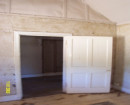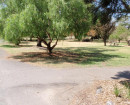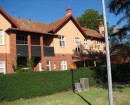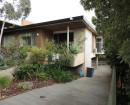ESSENDON TRAMWAY DEPOT
318 MOUNT ALEXANDER ROAD TRAVANCORE, MOONEE VALLEY CITY
-
Add to tour
You must log in to do that.
-
Share
-
Shortlist place
You must log in to do that.
- Download report
Statement of Significance
-
-
ESSENDON TRAMWAY DEPOT - History
A E Morgans, a private investor from Western Australia, proposed installing electric tramways from Flemington Bridge to Maribyrnong and North Essendon, and generating and distributing electricity. Government approval was obtained, and Morgans’ rights were taken over by the North Melbourne Electric Tramway & Lighting Company which had been formed in London. The tram depot and power generating station was constructed in Mt Alexander Road, Ascot Vale and the tramway opened on 11 October 1906. Prior to the tram services public transport through Essendon was provided by the main trunk railway from Melbourne to north-east Victoria, a service of horse drawn omnibuses from Flemington Bridge to Moonee Ponds, and horse drawn cabs. The Railways Department had earlier opposed construction of the Essendon tramways for fear that it would affect their revenue. In 1919 the Melbourne & Metropolitan Tramways Board (M&MTB) was formed to take over and consolidate most of the various separate tramways then in existence. A zig-zag air raid shelter trench was excavated in the 318 Mount Alexander Road, Travancore sometime before the 1945 aerial photograph was taken. The trench was filled sometime prior to 1951 and has now been covered by a bitumen tram yard and carpark. Please see attachment for more detail.ESSENDON TRAMWAY DEPOT - Interpretation of Site
There is one area of archaeological potential within the Essendon Tramway Depot site, comprising the Zig-Zag Air Raid Slit Trench. The area between the two northernmost buildings (Figure 3 2) does not seem to have been adversely impacted and disturbed since the construction of the buildings in the northern section of the site. The area primarily appears to have been a dirt surface, into which a zig-zag air raid slit trench was excavated during World War II. Sometime before or in 1945 a zig-zag air raid trench (slot trench) has been excavated in the northern portion of the Depot parcel. By 1951 however, the zig-zag air raid trench (slot trench) has been filled in and the layout of the buildings has not changed. The buildings in the northeast portion of the Depot parcel previously seen in the 1945 aerial appear to have been demolished. The buildings in the northern extent, including the powerhouse, have been demolished and replaced by a tram yard and carpark by 1963 and the ground surface appears to be entirely sealed with bitumen. Before 1979, formal car parking was established present adjacent to tram yard, overlying the location of the zig-zag air raid trench (slot trench). The ground would have been prepared for the formalised bitumen surface which probably required fill to create a flat and stable foundation. The carpark has remained in place since its construction and has provided protection for the underlying archaeological deposits. As part of the refurbishment of the depot in 2016 the tram yard appears to have been resurfaced. As such, it is likely that the historical ground surface, and the zig-zag air raid slit trench and the original asphalt tram shed surface, may still be present under the introduced fill. The Essendon Tramway Depot Zig-Zag Air Raid Slot Trench site meets the definition of archaeological site under the Heritage Act, as a site that is likely to contain artefacts, deposits or features 78 or more years old, that would provide information relation to the former use of the site, that requires archaeological methods to reveal such information. While there are no surface features, due to the asphalt of the extant carpark covering the site, there is aerial imagery showing that the zig-zag air raid shelter trench was extant in 1945. Photographic evidence of the Essendon Tramway Depot from the 1950s shows the zig-zag slit trench has been filled-in. The site has subsequently been levelled, possibly through the introduction of fill, and archaeological features associated with the slit trench are likely to still be in situ underneath the current carpark. The area has been used for carparking since approximately the 1960s and was formalised with a bitumen surface sometime before 1979. This is likely to contribute to an understanding of how Essendon Tramway Depot staff, and possibly the wider Essendon community, responded to the threat of World War II. As such the Essendon Tramway Depot Zig-Zag Air Raid Slit Trench site meets Threshold A (archaeology). As there is limited historical information about the Essendon Tramway Depot Zig-Zag Air Raid Slit Trench, archaeological investigation and detailed recording could provide information not available elsewhere, particularly in relation to the construction and use of the slit trench. The limited historical information suggests that Essendon Tramway Depot was one of the open areas around Melbourne utilised in this fashion, although, while it was built for the depot employees, it is currently unknown as to whether the Essendon community would also have had access to this slit trench in a time of crisis. Archaeological investigation could provide information about other slit trenches and their usage across suburban Melbourne. The site is significant in a local context under the ‘defending Victoria and Australia’ (Theme 7.4) in Victoria’s Framework of Historical Themes (Heritage Council of Victoria 2010). As such, the Essendon Tramway Depot Zig-Zag Air Raid Slit Trench site meets Threshold B.
Heritage Inventory Description
ESSENDON TRAMWAY DEPOT - Heritage Inventory Description
The site of the Essendon Tramway Depot continues to operate as an important tram depot for trams running route 59 (Airport West – Flinders Street Station) (Figure 2 1, Figure 2 2, and Figure 2 3) . The depot is in fair-good condition and is substantially intact, with minor to moderate modifications having taken place at various points over the last century (Table 3 1). The Essendon Tramway Depot currently comprises three buildings, a carpark and the double tram line fan associated with the tram stabling building. The building in the southern corner has been extended since it was first built. Carparking also lines the northern boundary of the Depot.
-
-
-
-
-
SWAN HILL WATER TOWER
 Victorian Heritage Register H2452
Victorian Heritage Register H2452 -
RULES OF THE MELBOURNE FOOTBALL CLUB
 Victorian Heritage Register H2428
Victorian Heritage Register H2428 -
MOUNT LITTLE DICK FIRE TOWER
 Victorian Heritage Register H2461
Victorian Heritage Register H2461
-
-









